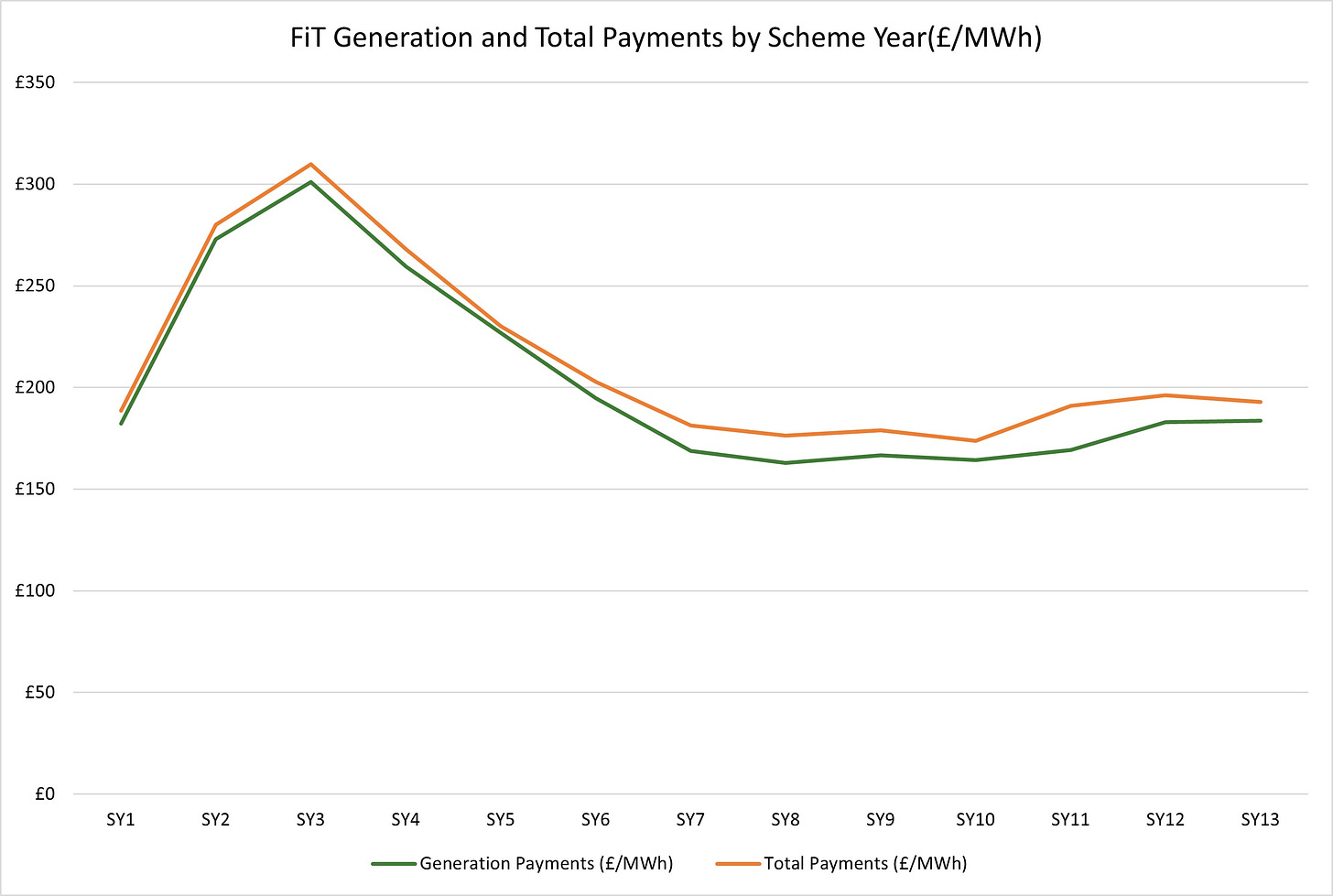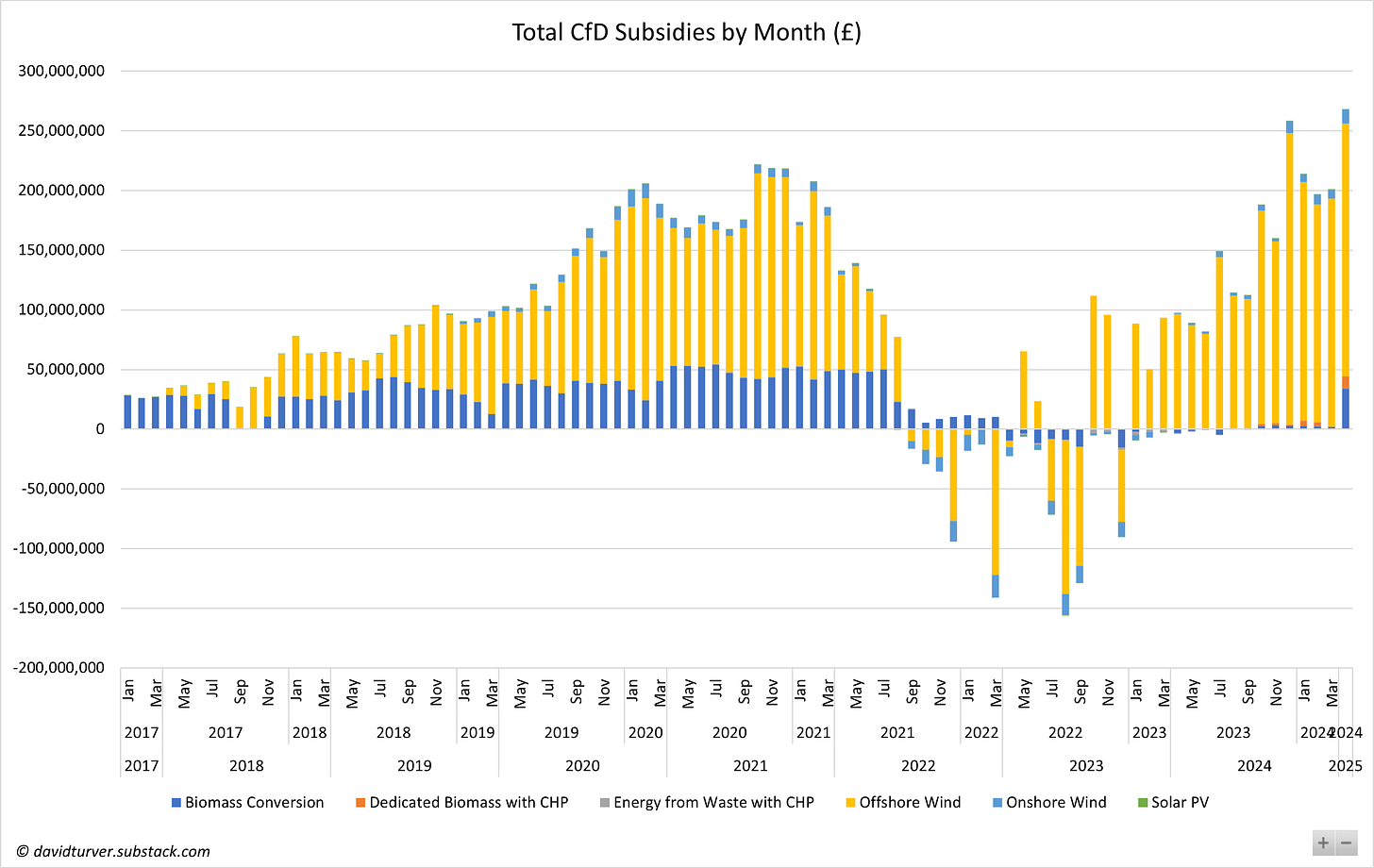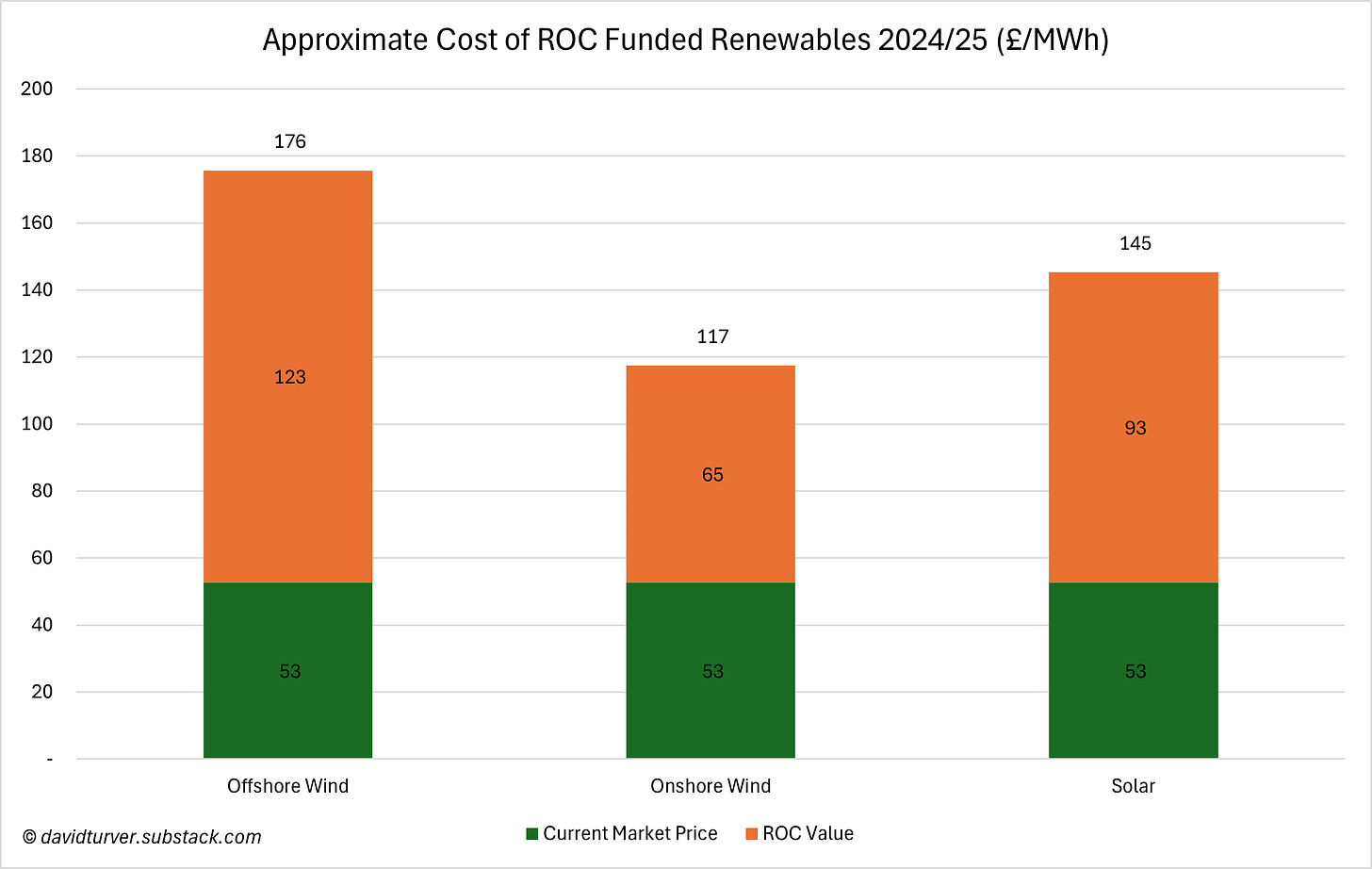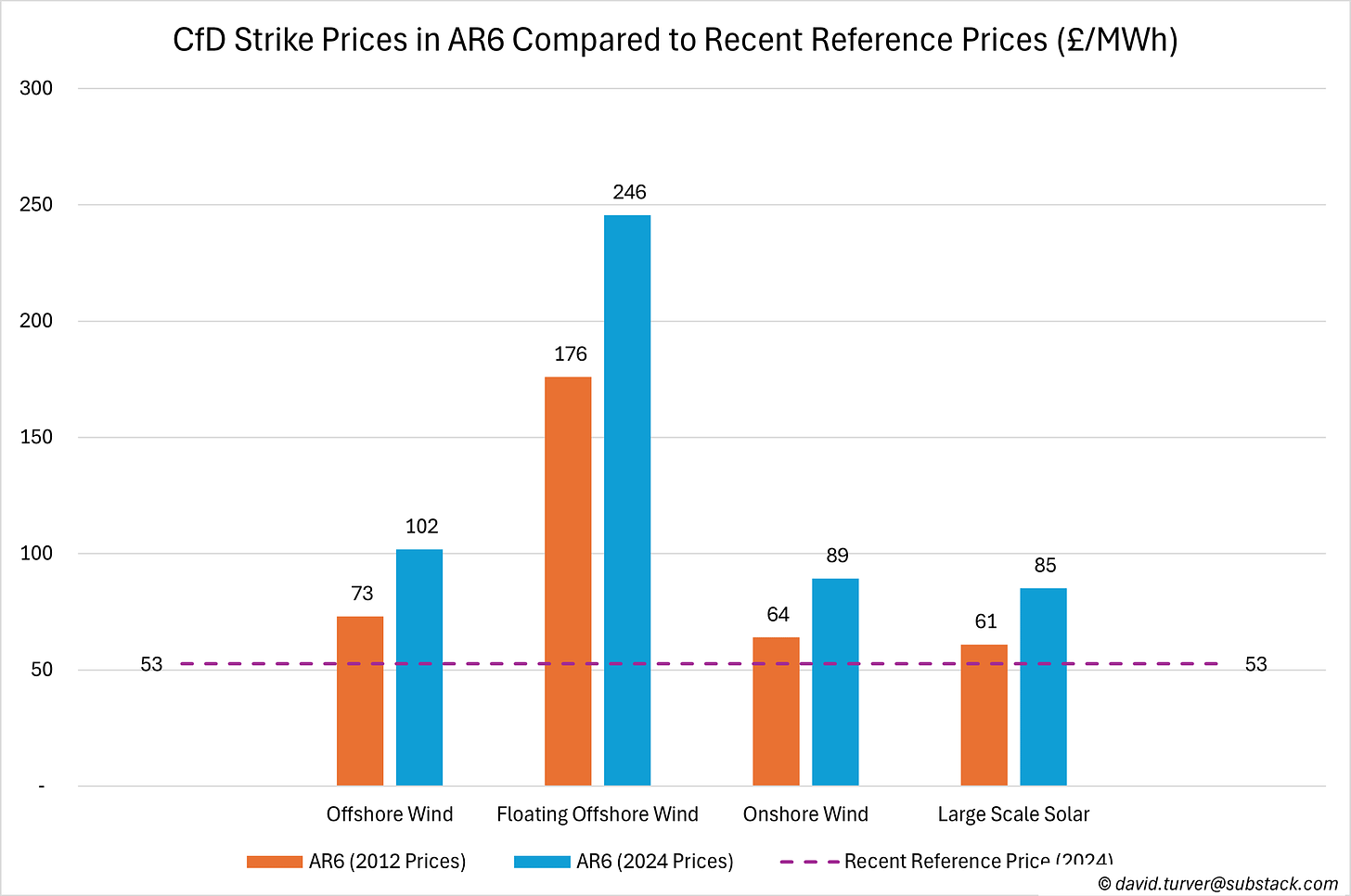Last week, I decided to write an X post to summarise how much we are paying for renewables. It got far more traction than I anticipated, so I thought it would be helpful to convert it and extend it a little to make an article that can act as a succinct response to all those who still insist on claiming renewables are cheap.
In the U.K., renewables are subsidised by three different schemes. Feed-in-Tariffs (FiTs) fund mostly solar power. The latest report for 2022-23 shows the scheme cost over £1.7bn and average total payment was around £193 per MWh, about three times the current cost of gas-fired power at around £65 per MWh (see Figure A).
Contracts for Difference (CfDs) fund a range of technologies, but most of the subsidy goes to offshore wind. Latest data from the LCCC shows the subsidy per MWh fell dramatically during the energy crisis, but is now back at £95 per MWh for offshore wind, £73 per MWh onshore and £60 per MWh for solar. April 2024 was a record month for overall subsidies with £268m paid out with average strike prices at £146 per MWh for offshore wind, £113 per MWh for onshore and £110 per MWh for solar power (see Figure B).
The CfD subsidy for burning trees in biomass plants rose from about £7 per MWh in March to nearly £60 per MWh in April. This encouraged more biomass generation and the total subsidy paid for biomass jumped from £2m in March to over £34m in April 2024. The total CfD subsidy paid for the last 12 months is over £2bn, and the trend is clearly upwards.
By far the biggest subsidy scheme is Renewables Obligations Certificates, costing over £7bn per year. This scheme awards certificates for each MWh generated, a different number depending upon technology. April reference prices for intermittent renewables have been around £53 per MWh, meaning the average price paid for offshore wind under the ROC scheme has been £176 per MWh, onshore £118 per MWh and solar £146 per MWh including the value of the certificates (see Figure C).
Future renewables are also going to be more expensive than current market rates. The Government’s announcements of prices for their Allocation Rounds are often quoted in 2012 money. In 2024 money, Allocation Round 6 (AR6) is offering £102 per MWh for fixed offshore wind, £246 per MWh for floating offshore wind, £89 per MWh for onshore and £85 per MWh for solar power, all far higher than current market prices (see Figure D).
It should be noted that FiTs, ROCs and CfDs are all index-linked, so prices will continue to rise with inflation. It is clear our bills are going to continue to rise for the foreseeable future as cheap gas is forced out in favour of expensive renewables.
In addition, we pay extra for balancing the grid when the wind is not blowing (or blowing too hard) and the sun is not shining. In the year ending March 2024, these balancing services cost £2.46 billion. Most of these costs should be attributed as a cost of intermittent renewables. That’s a total of over £12bn being paid to or because of renewables each year.
More costs are coming down the line as the National Grid ESO has announced £54 billion of spending on the electricity network infrastructure up to 2030 and a further £58 billion in the 2030-2035 period, a total of £112 billion, or over £10 billion per year for more than a decade.
I hope it is clear to all now that renewables are not cheap and are never going to be.
David Turver writes the Eigen Values Substack page, where this article first appeared.

















To join in with the discussion please make a donation to The Daily Sceptic.
Profanity and abuse will be removed and may lead to a permanent ban.
Brilliant article, shame it will never appear on the BBC. One can but hope that those responsible (and it’s an enormously long list) for Clown World rot in hell forever, because sadly they ain’t going to face justice on this earth for all the deaths harms and misery they have caused.
Bigpharma, their genetic “vaccine” engineers, medics who should know better (I’d guess that’s 80% of the lot).most of the NHS, the MSM, virtually all MP’s, the “government”, most celebrities etc.
Last but not in any way the least, 80% of the populace – the jab fanatics, the lockdown fanatics, the mask wearing fanatics and the sheep who went along with it all – who.couldn’t, wouldn’t and still don’t want to know or care about the truth. And most would do it all again.so easily is human nature manipulated.
Never forget.
Agreed, we are surrounded by wet, woke, wimps, too feeble to face the truth and reality of their pathetic complicity.
That was the really scary part for me – how people at work and family accepted the scare tactics without question – not a single person said ‘hang on a minute, this sounds like bollocks – where’s the evidence?’
Just showed how weak modern civilisation is.
Actually a large number did, even some Doctors, some of which were struck off by the GMC. As soon as the PCR cycle numbers became known, many knowledgeable people asked what was the test for, because the results were useless. But the Government insisted that this was the “Gold Standard”, well it was for their purpose to crash the Country as much as possible. It was all fraud on a huge scale, and somewhere there is a lot of cash, in the hands of a lot of complicit people. MY GP surgery is still saying it is “safe and effective”, so they are complicit, presumably because the NHS still claims this!
Didn’t lockdowns in China and Italy pre-date the Imperial fabrication? What about the input from Farrar and others, from the WHO and from bodies in US? Not sure everything can be blamed on Ferguson.
If you think “covid” exists I suppose you could characterise what happened as a “reaction” by governments, but if the bad flu season had been treated as other bad flu seasons had previously been treated, nobody would be talking about a “pandemic”. Technically maybe there was a “pandemic”, but the most significant things that happened were really created by governments and others, rather than reacted to.
Flu and cold viruses go round the World every year so technically there are yearly ‘pandemics’.
Exactly.
It was not just BSE figures that Ferguson was wrong about in the late 1980; he needlessly called for 600k cattle to be killed and burnt on pyres in 2002 for the Foot and Mouth outbreak. Previously, you killed only the cows in an infected herd not all the herds that touched that farm.
Again in 2009 he forecast 50k deasths with Swine fever and then the ridiculous 500k figure in 2020. How could at least 5 PMs believe this fellow. It is interesting that Ferguson’s boss fell out with the saintly Professor Gupta at Oxford and moved to Imperial College.
Maybe it suited them to believe him
I didn’t know that about his boss. Probably Gupta was too keen on the truth for his liking
Almost every country on the planet complied with the WHO/CCP/Gates instructions to lockdown. Gates had been going on about how unprepared the world was for the next pandemic, even though pandemics were becoming less frequent or deadly as more humans become wealthy and healthy. Gates was given a seat on the WHO giving him the same status as a country. Who decided he should be given this status, especially as he has no experience and track record as a doctor or nurse. I don’t recall me or anyone being asked if this was OK? The WHO changed the definition of pandemic a few years ago so that instead of various conditions being met only wide spread infection was enough to declare a pandemic.
The trigger for all that followed was the lurid news reports coming from China along with dramatic imagery. Once the global population had been primed nearly all governments were captive to panicked populations and could only administer what the populations demanded.
Gates had his universal entrance ticket… $$$$$$$$$$$
The Zero-Covid Soviet style propaganda was pervasive and well co-ordinated.
I recall the following illustrious organisation being involved with the following examples:
UNHCR (UN Refugee Agency): “Statement: No-one is safe until everyone is safe – why we need a global response to COVID-19”
WHO: “No one is safe from COVID-19 until everyone is safe.”
UN: “No one is safe, until everyone is”
GAVI: “No one is safe until everyone is safe” (GAVI was set up by Gates and Melinda)
USGLC: “FACT SHEET: No One Is Safe Until Everyone Is Safe”
And…The FT/Euro News/Education International ‘No one is safe until everyone is safe’
Even ‘ourworldindate‘ repeated this assertion even though it’s title professes a dispassionate scientific ethos. Obviously not.
I also came across this full page advert in the Daily Telegraph 26 March 2021 ‘GLOBAL VACCINE EQUITY’ paid for by the New York City Department of Health & Mental Hygiene.
The advert goes on about inequality in global vaccination and how Covid ‘vaccines’ need to be given to the Global South – “Committing to producing at least 15 billion mRNA doses in the next 6 months, including investing in manufacturing capacity in the Global South.” even though this virus has been round the planet and also poorer countries have life expectancies that is too low to be susceptible to this particular virus.
The advert ends:
“The nations of the G20 can change the trajectory of the COVID-19 pandemic while building global resilience and global solidarity. The Health of each country impacts the health of all countries – the time to act is now.”
“An aerosolised virus also makes most masks pointless as the virus is so small that a non-surgical mask is no barrier.”
No. All masks were pointless. Medical masks are to prevent bodily fluids being either spat out or ingested, and nothing else.
The packets of medical masks that we were buying from China even say on the packaging that they are NOT recommended for children and are NOT PPE (see below).
In January 2022 Stephen Petty, an expert on industrial hygiene, spoke to the Senate Health and Human Services about the effectiveness of masks. In short there was/is none.
https://www.youtube.com/watch?v=aEwi_NUpk0k&t=325s
Stephen Petty, Expert, Industrial Hygienist gives solutions far more effective than masks
And a lot of it was junk on sale in the usual stores, and if you used a magnifying glass you could read the get-out clauses printed on the labels; I never bought any, and never used any of them.
Propaganda, falsification and censorship started before a single person died in the UK.
For me, it started the moment the authorities declared that Covid can’t have escaped from a lab and anybody posing the very reasonable question “is this really such an implausible explanation considering there is an institute of virology in close vicinity of the origin of the outbreak?” was immediately deemed a racist, despicable conspiracy theorist.
At that precise moment the whole “follow the science” idea, objective search for the truth and fact-based enquiry disappeared in a big, spiraling vortex of propaganda.
For me that was the moment when they started lying.
Here is a 2020 transcription of a BBC interview of a Ugandan Nurse about why the pandemic didn’t seem to be so bad there. Why did the BBC, in this case Nick Robinson, think it would be worse in Africa?
“It’s coming up to 19 minutes to nine. It’s not very long ago that we were told that the coronavirus pandemic could have a terrible impact on Africa, a continent that has suffered terribly from the effects of Ebola and AIDS, but so far at least, so far it has not turned out that way. This week we’re examining how the virus is affecting developing countries around the world. In a moment we will hear from the World Health Organisation. First though the picture on the ground in Uganda. A country that has so far recorded no deaths from COVID-19. I’ve been speaking to a nurse in a General Hospital in the Rakai district of Uganda; Maria Nekalanda”:
Maria: We really haven’t seen many patients of the symptoms of Covid. Like we have the measures in place, we do have the tests for outpatients that are coming in, but actually we have not recorded anyone.
Nick: So, is it turning out to be nothing like as scary as maybe you thought it would be a while ago?
Maria: Well, in the start we actually panicked. We were thinking, Oh my god, we are going to be the next dead people and it turned out that over time we stopped panicking and understood that probably this whole Covid situation is just not going to be as bad.
Nick: Are you saying that you’re no longer scared of COVID-19?
Maria: Yeah, we are no longer scared. We are following guidelines, but we are continuing with work.
Nick: And do you have all the protective equipment that you would want to have?
Maria: No, that’s actually a part of what stopped scaring us because for a greater part of the season we did not have protective gear. The health workers on the ground that are also handling general patients are not protected.
Nick: What about for the people who have this? You’ve seen people who get Ebola and how serious that is. How does Covid compare for them?
Maria: Comparing Covid to Ebola will be a kind of joke to the many Ugandans that have lived to see the impacts of Ebola, because people can deal with Covid 19 and they eat normally, they interact in communities, until probably they are found out and they are literally interacting with each other. That doesn’t happen with Ebola. Whilst there is an Ebola outbreak in the region pretection is at the very high pitch. People don’t keep running in at out of those particular areas. But for Covid you realise having Health Ministers come to places where Covid 19 is unchecked and Ebola is like 100 times worse.
Nick: Tell me about the lockdown in your area of Uganda or in Uganda as a whole if you like? What sort of lockdown is it and are people happy to go along with it or are they very frustrated?
Maria: People are actually frustrated because they have been financially affected. They’ve lost a lot in business. They are struggling to put bread on the table. They are like “well, you’re talking about a pandemic which I haven’t been able to go to work, why don’t you let me work?” So the whole lockdown situation is like a punishment.
Nick: Have you any theories why Covid is much less serious in Uganda than it seems to be in the UK for example?
Maria: I would think about the lifestyle. Ugandan’s they have probably access to more organic food. Lower cases of chronic illnesses like obesity. But um…we just think we have a bit of unexplained immunity to that disease. We are not dying just as bad.
Nick: That was Maria Nekalanda a nurse in the Rakai district of Uganda and listening to her is Dr Mary Steve a public health expert at and WHO Africa based in Congo. Good morning to you.
I did not transcribe the rest of the interview but it is important to note that the ONS recorded the average age of death from Covid as just over 82 years, while life expectancy in Uganda is 64 years. Ugandan lifestyle is so much better than the West because the average Ugandan never got old enough to die from Covid!
The government downgraded the Covid risks on I believe the 18th March yet a couple of days later we were locked down. The Plandemic was the biggest crime against humanity, and yet no one has been punished!
Excellent article. I’ve posted it on FB. Maybe it will make a few pro vax, lockdown fanatics think twice before trolling the voices of scientific rationalism and sanity.
Re “The mortality data” issue, it reminded me of the old case of Dr. Harold Shipman, the serial murderer who killed lots of his patients, and subsequently committed suicide in prison. They tightened up on death certificates after that, but they appear to have reverted to the old method to some degree. Shipman would have loved it; he would have literally got away with murder.
Those giving Midazolam and Opioids together did. Under instruction from the Health Minister. I suspect he is now extremely rich.
Yes, brilliant. I hope Rachel will cover the scandalous withholding of effective treatment from covid patients – vitamin D, ivermectin, fluvoxamine, hydroxychloroquine and others, even vitamin C, all of which were pooh-pooh’d by the medical establishment. Distinguished medics in the USA such as Peter McCullogh definitively demonstrated otherwise, curing many patients who would otherwise have died.
Treatment was withheld in order to justify emergency authorisation of the forthcoming vaccines, a policy tantamount to state-and pharma-sponsored homicide on a massive scale. Worse still, the one drug authorised in the USA was remdesivir, which was toxic and sometimes fatal. In my opinion the excess deaths were primarily the consequence of this policy of not treating the disease, just waiting for the vaccines. Considered globally, the deaths so caused amounted to a holocaust.
This, in my opinion, was the most wicked aspect of all.
I refer to it in When the Towers Fall (on the Book of Revelation), which inter alia points out that the merchants of pharmakeia are one of the reasons why godless civilisation according to the prophecy is finally brought to an end.
The incompetence of the medical profession is staggering and the stupidity and gullabillity of politicians is laughable but never mind, chuck a few knighthoods and damehoods at the fools and problem solved
I completely agree, but you need to add medical professionals and medical doctors to that list of ‘stupid and gullable’ people.
Over the years, some of them have done a good job for me, but it appears to me that the structure of the profession is a group of specialists that do not necessarily understand each other, or communicate effectively internally. Sometimes you’re lucky who you deal with, sometimes not.
As a profession it seems to me they generally don’t want to question anything – this is odd given theirs is in theory a science based industry… thinking about it, there is basically no reward in challenging anything, however there is reward in NOT challenging the narrative, and keeping the gravy train going
The quickest way to stop this nonsense is to request the following is presented independently, transparently and repeatedly:
1) evidence of particles, presumed to be ‘viruses’ that have been directly purified and isolated from the fluids of a sick human or animal, without the use of culturing, and then confirmed through electron microscopy.
… and
2) evidence that purified and isolated particles have been proven to be pathogenic naturally through adherence to the scientific method and through the satisfaction of Koch’s Postulates
The logic of the scientific method seems to elude virology, virologists and other scientists too lazy to critically think. The fact no vaccine has ever been needed is a huge inconvenience to the pharmaceutical-industrial complex…alas, the gaslighting continues.
I’ll happily walk anyone interested through the logical steps required to prove an invisible microbe within a host is causing disease.
One compounding factor was the change in the definition of a”case”.
It was no longer symptoms +positive test but just a positive test.and as the deficiencies, outlined in this excellent article, of the PCR test highlight.
No shortage of revised definitions without explaining why, to the point of deliberately exploiting common understanding to assist the promotion of various things.
There WAS no pandemic.
There was a nasty little virus which did what nasty little viruses tend to do …… take out the very elderly who don’t have long to live anyway, and those who are vulnerable because they are already in very poor health.
The whole thing was a scam orchestrated by people and organisations which intended and expected to gain from it.
Fun fact: viruses (or virus-like particles) are a result of illness, not the cause i.e. they appear to detox/clean up the cells. This has been repeatedly demonstrated in properly executed control studies. Environemtal toxins cause disease, not invisible pathogenic viruses that have yet to exist outside of a computer database. Until this backward thinking is reversed, the medical establishment will continue to needlessly harm and kill people.
Germ theory needs some serious modification.
If only Bechamp had won.- bigpharma would have no reason to exist.They have no good reason to exist anyway, but we are where we are thanks mainly to Pasteur and the Rockefellers.
The FACT that no one has a sample of pure Covid, or an electron micrograph, or a proper genetic sequence (because a pretty pure sample is needed to get that), explains why they kept showing the ridiculous computer alleged pictures in technicolour! Never mind, it was all part of a designed massive deception.
The following is from Denis Rancourt (https://denisrancourt.ca/):
Censorship and deplatforming are characteristics of a totalitarian state.
(I have been permanently deplatformed from several main professional and scientific venues, and my work has been extensively deleted from YouTube, Facebook, and scientific journals and media — for being objective about Covid-period measures and vaccines — not to mention regular “fact checking” and personal attacks.)
IN MY OPINION:
COVID, Swine Flu, Avian Flu, SARS…
Objective harm analysis proves that the “pandemic” global- response structure should be dismantled.
The said structure is a political instrument for globalism, colonialism, and publicly-funded Pharma mega profits, disconnected from reality for viral respiratory diseases.
The pandemic responses have been unjustified and harmful disasters.
Furthermore, looking at all-cause mortality by time (by day, week or month), across all nations with seasonal winter-burden deaths, since WWII, the declared “pandemics” are not statistically different from the “non-pandemics”, which is a hard scientific fact.
I conclude that “pandemic” is a fictitious phenomenon, a word used to instill fear and to manipulate for power and profit.
Denis Rancourt 9 July 2021
Related suggested reading: ‘Virus Mania’ book by Torsten Engelbrecht and Claus Kohnlein
And Dr Sam Bailey. Excellent book. Videos on https://odysee.com/@drsambailey:C
HART produced the People’s Vaccine Enquiry which has been available on line for many months now with expert medical evidence easily accessible on the HART website. Several members of HART have only recently returned from Belfast and Dublin where they gave excellent presentations.
HART is the work of numerous experts who have worked assiduously and voluntarily in the public interest from the start of the pandemic. They have done a massive amount to raise awareness of the serious issues and to fight for the cause, often at considerable personal cost to themselves, including government surveillance.
i am sure this article and the video are extremely helpful in bringing to the fore scientific evidence but I can’t help thinking a more collaborative and cohesive campaign to highlight the problems for the public would be of much greater value than an individual presentation.
Unfortunately dissipating the efforts to reveal the truth risks losing the required and very necessary impact.
Great article, thank you for taking the time (and professional risk) in putting this article and video together. Standing up for actual science and logic, in this mad world we now find ourselves in.
Mostly correct but a couple of small errors. In the interests of accuracy:
“An airborne (aerosolised) virus stays in the air indefinitely and can travel long distances on the air, crossing continents…Zero Covid (sealing borders to prevent the virus arriving), advocated by several prominent U.K. politicians, could therefore never work, as was seen in both China and New Zealand.”
In fact New Zealand at least did successfully keep out the virus. (Of course when the borders were reopened, the virus came in very quickly as it was always bound to do, so nothing was gained in the long run.)
“We were encouraged, and sometimes coerced, to use hand sanitisers, which were toxic to our immune systems…”
Really? Obviously they did no good against an airborne disease, but “toxic to our immune systems”?! They are normally based on alcohol, so if they are toxic to our immune systems, I dread to think what a stiff Scotch might do!
Regarding hand sanitizer, I agree with Dr Nicoll here. The amount of alcohol in hand sanitizer ranges from 40% to 95%…beer and wine is only 3-10% and 10-15% respectively. Also, some sanitizers contain ingredients that are very much toxic to humans, especially children (e.g triclosan)
What a pleasure to read such a calm, logical and reasoned account. Some of us knew or at least suspected all this almost immediately. Thank goodness for Lockdown Sceptics (as was) without which I for one would have despaired during those absurd days.
Fantastic work done by this proper doctor, beautifully explaining complicated medical immunology in a way that is understandable to a layperson. Exposing one by one the abuses to humanity of deplorable policies by the ludicrous SAGE cabal. So many need to go to prison.
This account is a proper valid and honest Covid enquiry. Bravo.
A good written summary, worth bookmarking.
Two words we should also remember.
Then there was the fly-on-the-wall documentary inside one of the the testing labs which showed shameful slap-dash methods and zero hygiene, with extreme government pressure to get x,000 tests out each day.
Then there’s the huge ramping up of these so-called tests and then using the inevitable increase in so-called ‘cases’ to justify anything they damn well wanted.
Then there’s the statistical blindness of the media zooming into a tiny section of a chart and using a tiny blip to claim it’s getting worse again.
And many more I’m sure but they all blur into one. I followed them all so closely at the time and I took screenshots to help me remember.
I’ll watch the video later, so perhaps these points are also covered.